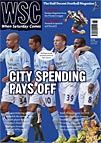 The art of the programme is alive and well in the lower echelons. Owen Amos flicks through the pages
The art of the programme is alive and well in the lower echelons. Owen Amos flicks through the pages
Once, football clubs had programmes. Now, they have matchday magazines. They have shiny covers and shameless names: Blue Review, Red Watch, or worse. They are, they stress, official – as if, somewhere, there’s a thriving market in knock-off Southend United matchday magazines. And, of course, cliche wafts into every corner, like smoke in a taxi. Worst of all, they cost £3.
But, like videos and vinyl, programmes exist, if you know where to look. Places like West Allotment, in the Skills Training Ltd Northern League, where match reports go like this: “The pitch wasn’t great – it looked like a green version of Oor Wullie’s hair.” Or this, for a cup match at Bridlington: “It was the type of day at the British seaside that triggered the demand for overseas breaks.”
At Marske United, in the same league, the programme has a contents page, an A-Z of Marske players through history and, best of all, Col The Kit Manager’s page. It’s 80-plus pages, and costs 50p; better value than your average newspaper.
Marske’s programme has, for the past eight years, been edited by Moss Holtby, 26, a hospital security officer. It has, once more, won the Northern League’s programme competition; three seasons ago, it won the national non-League prize. Work starts the day after a home game and, by the time it’s written, printed and stapled, can take 40 hours. Why bother? “I don’t know,” says Moss. “I’ve won all the prizes I can win. I just must be different.”
FA rules state every club from Step Six up – that’s Northern League Division Two, South West Peninsula Football League Premier, Combined Counties League Division One etc – must have a programme. Most are perfunctory. Marske’s is near-perfect. It has no shiny pages but oozes character. Where else would you find a 500-word match report, with fans’ comments, on an away match at Darlington Railway Athletic, attendance 52? It costs the club money – “The price of ink keeps going up,” says Moss – but it’s a fantastic advert. All this for a readership of 70, from an average gate of 150. But next to Brandon United, that readership is Sunday Times-esque. Their programme’s print-run is 15. It too deserves a bigger audience. Each issue, for example, includes a piece on the opposition town. Not the club – the town. In a league that includes clubs from Cumbria, Tyneside, County Durham, Teesside and North Yorkshire, there’s much to learn.
It’s produced by Dean Johnson, a prison officer from Durham. He doesn’t even support them: he’s a Blyth Spartans fan. After editing the Murton programme for three years, before they were relegated, he saw an advert from Brandon in the local paper. He responded and, since the start of last season, has done their programme. It takes him around two hours per night, a few nights a week. Now Dean spends more time at Brandon than Blyth. “They need the help a bit more,” he says. “I set up nets, get them in at full-time, do the hospitality at half-time.” The programme – sixth in the Northern League competition – is packed. “I like to give people something to read at half-time, or in the car going back,” says Dean.
Brandon’s programme, at £1, helps pay the referee’s fees. But, down at Step Six, there’s more to football than making money. The programmes, at worst, offer a squad list and a league table. At best – like at Brandon and Marske – they manifest the non-League game’s beating heart. They let people know not all football comes with 25 cameras, music after every goal and 8ft furry mascots. In short, they’re folded, photocopied, A5 love letters. But with better statistics.
From WSC 268 June 2009